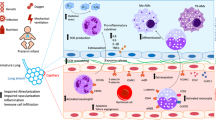Abstract
Chronic lung disease (CLD) of preterm infants has a multifactorial aetiology. Oxygen toxicity, mechanical injury (barotrauma), volutrauma as well as prenatal and postnatal infections most likely contribute to pulmonary injury in the immature lung of preterm infants. There is sufficient evidence that respiratory distress syndrome and CLD are associated with a significant inflammatory response of the airways and the interstitium of the lungs; besides neutrophils, alveolar and interstitial macrophages immunoreactive for tumour necrosis factor-α (TNF-α) are found in large numbers. Phagocyte influx is possibly mediated by chemotactic and chemokinetic factors present in the broncho-alveolar secretions: interleukin-8, leukotriene B4, C5a, elastin fragments, macrophage-inflammatory protein-1α and other chemokines. Increased concentrations of soluble selectins and intercellular adhesion molecule-1 in broncho-alveolar secretions and the serum of infants with CLD possibly reflect neutrophil diapedesis. Lipid mediators including leukotrienes, prostacyclin, platelet activating and other mediators such as the pro-inflammatory cytokines TNF-α, interleukin-1 and -6, exert various effects on the airways and the vascular system by increasing the microvascular permeability which is one of the most important pathophysiological factors of early CLD. Pulmonary cells of preterm infants may be unable to downregulate inflammation through the expression of the anti-inflammatory cytokine interleukin-10. Inflammatory cells can cause severe lung damage by release of potent proteases (elastase), cytokines and by generation of toxic oxygen radicals (O2-, •OH). The presence of free elastase acitivity and the protease-antiprotease imbalance has been well documented. In fact, increased concentrations of products of elastolytic fibre degradation and of oxygen radical mediated lipid peroxidation were detected in infants with CLD.
Conclusion The complex interaction between mediators of inflammation and fibrosis has still to be defined. Moreover, the possible interference of inflammation with postnatal lung development especially with the alveolarization process has not been evaluated yet.
Similar content being viewed by others
Author information
Authors and Affiliations
Rights and permissions
About this article
Cite this article
Speer, C. Inflammatory mechanisms in neonatal chronic lung disease. Eur J Pediatr 158 (Suppl 1), S18–S22 (1999). https://doi.org/10.1007/PL00014314
Issue Date:
DOI: https://doi.org/10.1007/PL00014314




